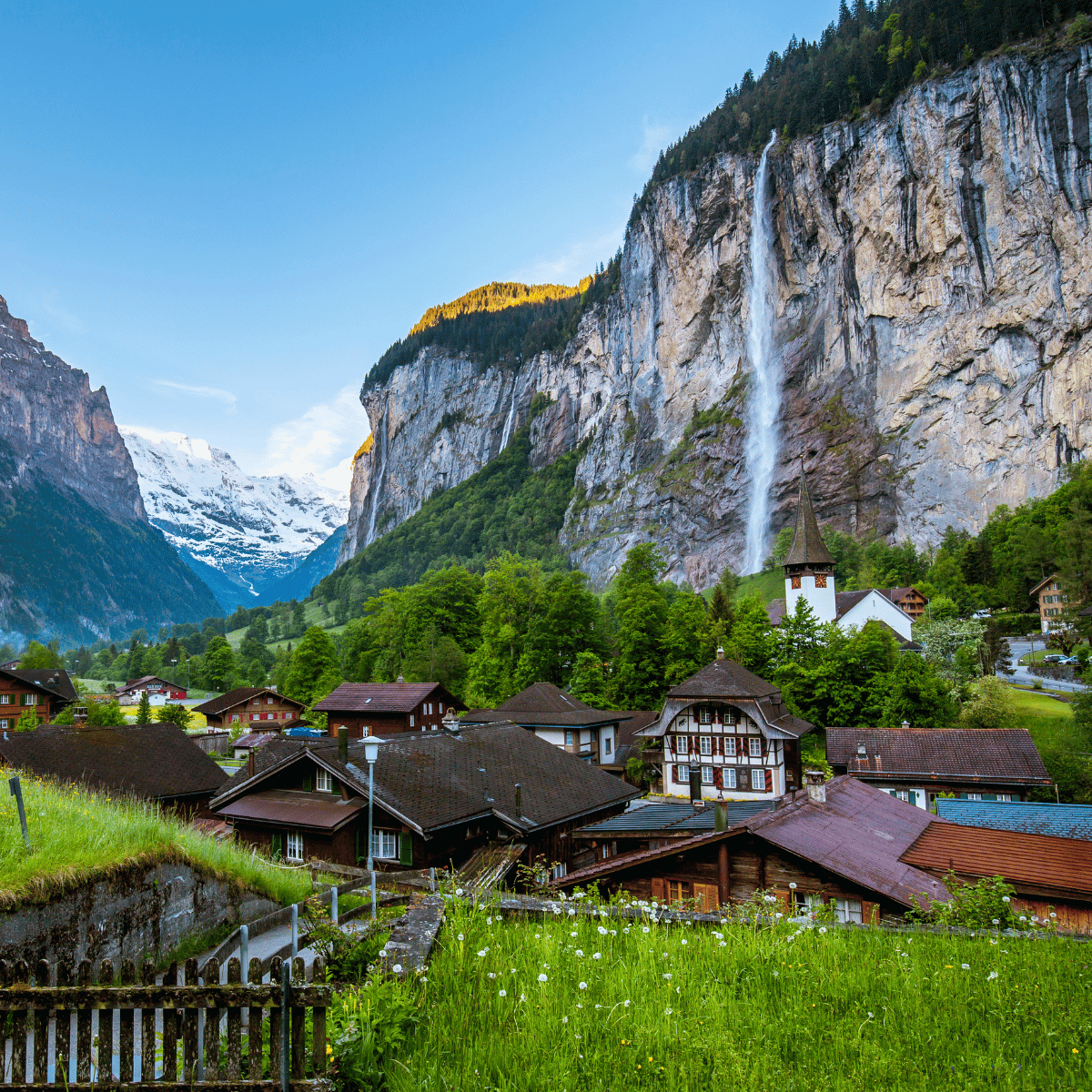The best waterfalls in Europe offer an ideal hiking destination for people who want to inject some wonder and slow adventure on their next trip.
From the Azores to Albania – The most breathtaking waterfalls in Europe
Whether you’re a professional photographer looking to capture Europe’s highest waterfall, the cascading beauty of the Dinaric Alps waterfalls, planning an epic hiking date or a simply a waterfall enthusiast wanting to experience the raw power of the soaring Alps Waterfalls, there is something for everyone on this list of waterfalls in Europe.
Biggest and Best Waterfalls in Europe Youtube
I’ve created a bucketlist of a wide variety of waterfalls, from tiny hidden Ehrbachklamm in Germany to the Iconic Iceland natural wonders. Each waterfall comes with detailed hikes to get to the waterfall safely.
Top 17 European Waterfalls
Read until the end, where I highlight some tips for hobby photographers to get epic waterfall shots like the ones highlighted here.
Waterfall obsessed? If you love mountains, you can check out the best Alps waterfalls or if love is in the air and you want to take someone to the most romantic european waterfalls I’ve got you!
1. Iceland: Seljalandsfoss & Gljúfrabúi – Best Walk Behind
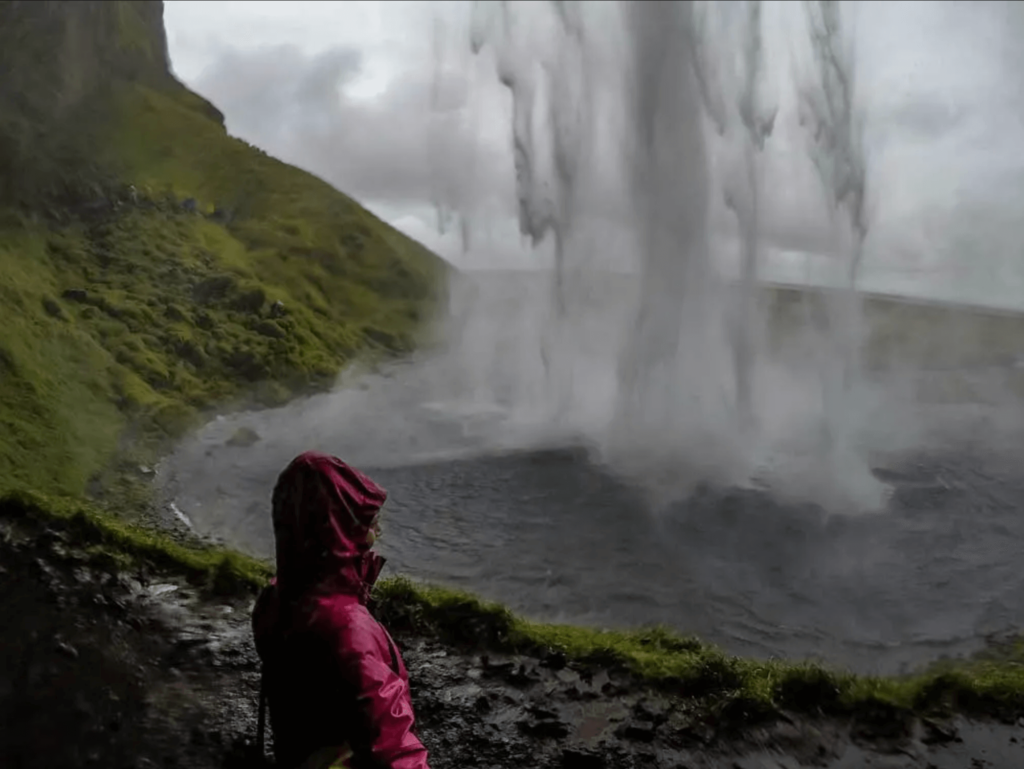
by Nina from Where in the World is Nina
We can guarantee that you’ve seen gorgeous photos of Seljalandsfoss, one of Iceland’s most epic and beautiful waterfalls, but you may not be familiar with Gljúfrabúi. Both of these stunners are located in the south of the country, and are part of the famous Golden Circle route. Seljalandsfoss is sixty meters high which cascades down the famous Seljalands river.
Seljalandsfoss is exciting because you can walk behind the falls, and experience the thunderous sound of the water up close. Be careful! You will get wet. Definitely wear a rain jacket and keep your camera in a bag.
There is a high concentration of waterfalls in Europe. You’ll notice Iceland featured frequently. If you’re a waterfall enthusiast, there’s no better place with such density of incredible waterfalls. The hiking is pretty out of this world and filled with hidden dwarves too!
Gljúfrabúi, located just a few kilometers away from Seljalandsfoss, is more of a hidden waterfall. In fact, so many people skip over this gem! But it’s a crying shame because it’s just a short stroll over from Seljalandsfoss. It’s tucked away in a narrow ravine, and you can only peep the falls from the entrance OR by trekking through the ankle to knee-deep ravine to get up close. It’s cold!
This is another waterfall that you will definitely get wet at if you decide to walk up closer. Not only are you walking through the ravine but you will be right up in front of the waterfall, it will be impossible to keep dry. Due to the narrow ravine, the sound of the water is incredibly loud and echoes off the walls. The water cascades down 20 meters, before flowing into a shallow pool at the bottom.
2. Azores: Poço da Ribeira do Ferreiro – Best Verdant
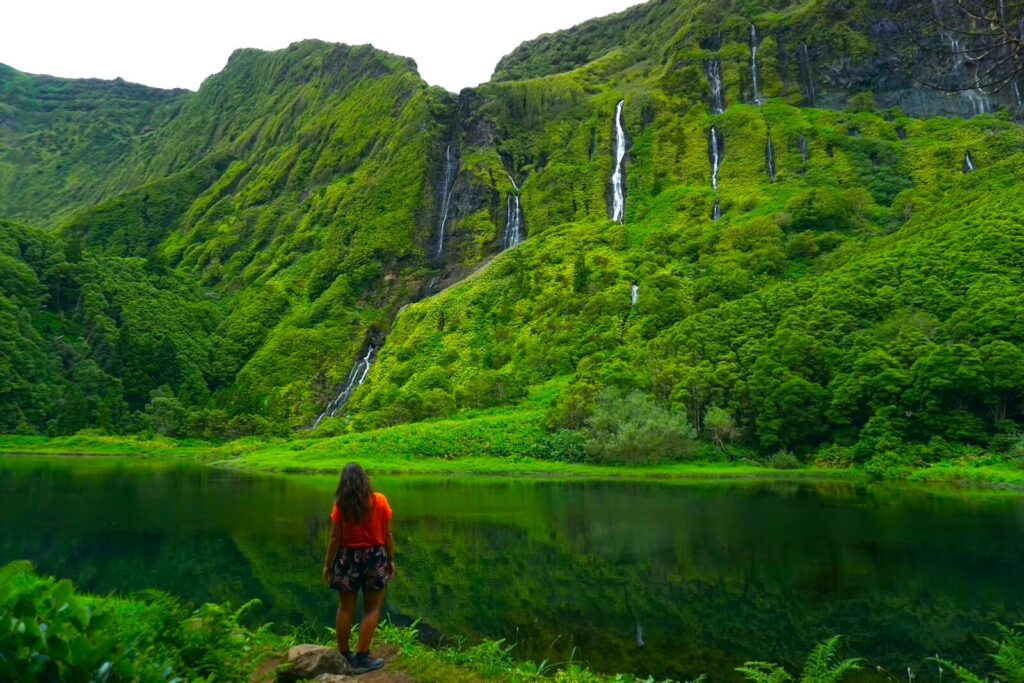
by Inês at Random Trip
Portugal hides an authentic setting worthy of a sequel to a Jurassic Park movie and it’s located in the westernmost territory of Europe: Flores island, in the Azores archipelago. The Poço da Ribeira do Ferreiro’s gem is not just a specific waterfall, it’s a green cliff of about 200 meters high splashed by many breathtaking waterfalls reflecting on a beautiful lagoon.
The 800-meter trail to get there (park here, the trail starts here) is lovely, through Flores forest. Bear in mind that the trail is a bit slippery with some loose stones but not that difficult, especially if you change your flip-flops into sneakers and your bathing suit into shorts if you just took a dip in amazing Fajã Grande or in the Poço do Bacalhau, another impressive Flores’s waterfall.
Wrap the day up with a delicious meal at Maresia: it’s not a restaurant, it’s an experience. It’s almost like Jorge, the owner, is inviting you to his living room directly into the sunset in the Atlantic Ocean. You don’t get to choose much, there are only a couple of options on the menu for the night, but his 800 vinyl collection playing in the speakers outside, a lovely Pico island wine, and his company make it totally worth it.
3. France: Silians la Cascade – Best in France
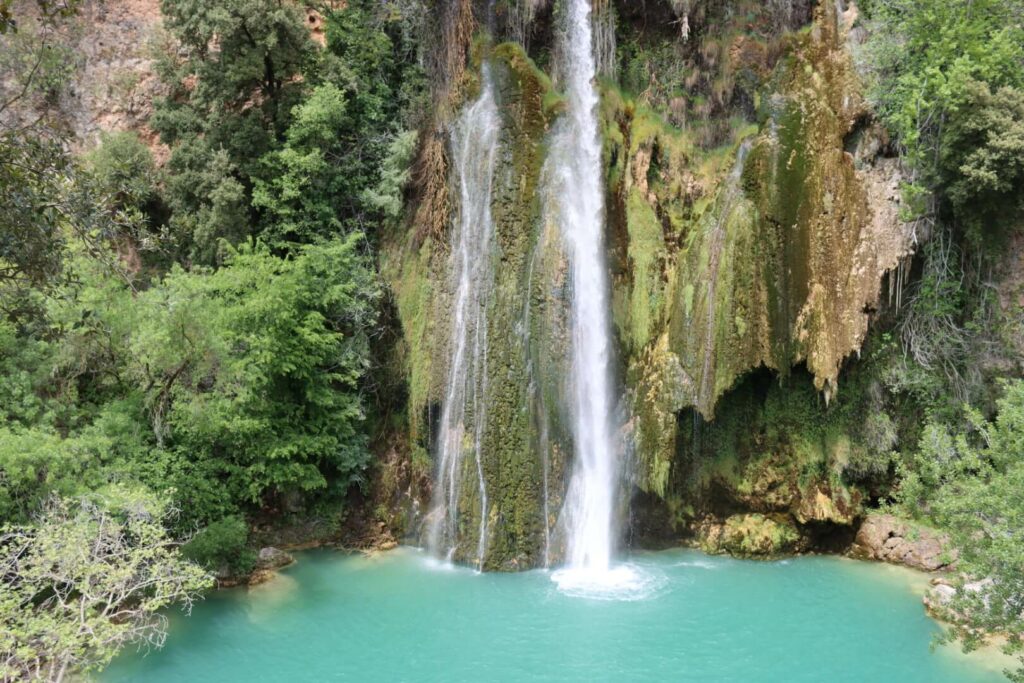
Sillans-la-Cascade is a beautiful natural wonder and one of the best waterfalls in Europe located in the Var region of France. With its breathtakingly tall waterfall, incredibly blue water and lush green vegetation, it’s no wonder why this area is a favorite among nature enthusiasts.
The hike to reach Sillans-la-Cascade is around two miles long. You will be walking along a river, and going down a few stairs. It doesn’t require a lot of effort to get to the viewpoint.
You’ll be able to enjoy stunning views of the waterfall from various vantage points along the route. Its height is an impressive 78 meters (256 ft) and makes for an awe-inspiring sight.
Keep in mind that you’ll be able to see the waterfall from the platform, but it’s forbidden to go down and swim in it.
Sillans-la-Cascade is ideally located in the south of France, near the famous Gorges du Verdon. It is a wonderful canyon of blue water surrounded by green mountains, where you can go kayaking, rafting, paddling or even swimming.
4. Croatia: Veliki Slap – Best Multi-Waterfalls
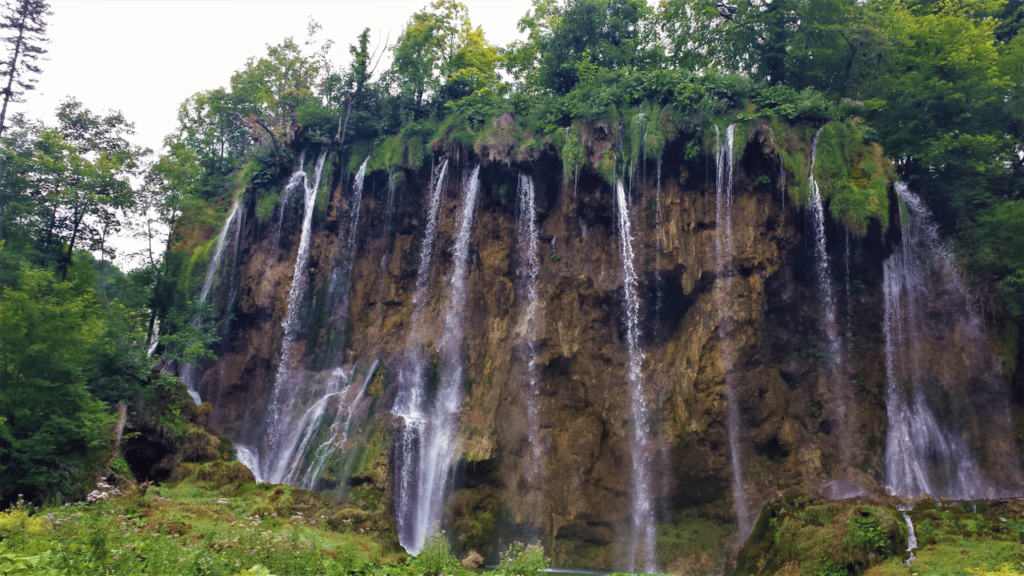
By Lara at the Best Travel Gifts
Some of the most beautiful waterfalls in Croatia can be found in the Plitvice National Park. This world heritage-listed park is home to sixteen different colored lakes that are interconnected through no less than 90 different waterfalls.
Each waterfall is different in shape and size and deserves a quick visit while you are there. The largest waterfall (and arguably one of the most impressive ones) is The Veliki Slap waterfall. Veliki Slap literally means the great waterfall and with its 78-meter drop, it’s indeed the highest one in the park. It’s fed by one of the most beautiful lakes, Plitvica Selo, and runs in the Korana river.
There are three entrances into the Plitvice National Park, and from each entrance, you can hike up to the waterfall. The entire park is laid out with easy trails, boardwalks, and hikes, though some cover more distances making it slightly harder. The closest entrance to Veliki Slap is number one, from there it’s a really short walk (5 minutes) to the viewpoint of the Veliki Slap.
However, as a UNESCO heritage site, Plitvice National Park sees lots of visitors, especially during the high season (July and August), so make sure you arrive early to avoid crowds. Also keep in mind that you are not allowed to swim in the lakes or at the waterfall, and you need to buy a ticket for the Plitvice National Park in order to visit the waterfall (between 75 – 299 KN, depending on the time and season of your visit).
You can buy your ticket online from the official website or at the park entrance (until 13:00). Though keep in mind that tickets sell fast during high season. You can also buy a two-day ticket, which is a great option if you’re planning to stay in the area and want to explore more waterfalls, lakes, and trails of the park.
5. Scotland: Grey Mare’s Tail – Best Waterfalls in Scotland
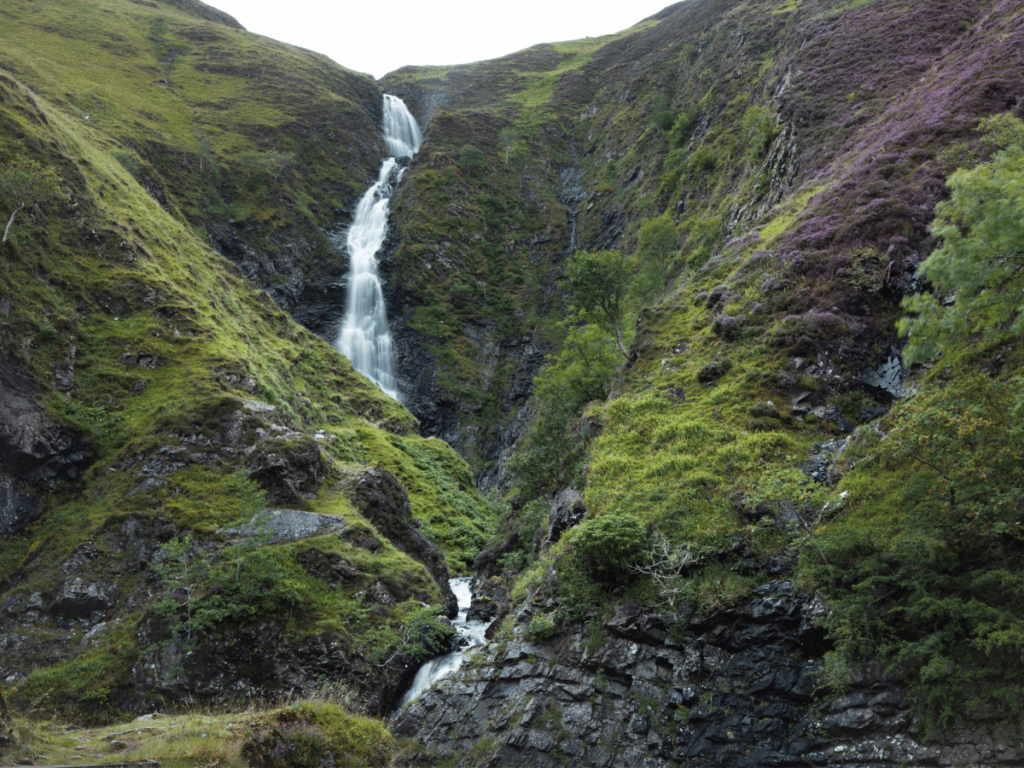
By Ela & Beata at Stunning Outdoors
Scotland is a home to many beautiful waterfalls, located all across the mainland and on many islands. One of the finest and highest waterfalls, plunging 60m down from Loch Skeen, is Grey Mare’s Tail, located in scenic Dumfries and Galloway.
The best way to admire the waterfall is to set off for a hike up to Loch Skeen. The trail is rather steep, rising above the gorge with many spots where one can stop to catch a breath and enjoy the waterfall view as it cascades down.
Thankfully a large parking lot located along A70 north-east from Moffat serves the hike and easily accommodates all keen visitors. The trail to the loch is visible from the car park as it rises sharply, and you will see the first glimpse of waterfall early into the hike, at the first sharp turn.
The walk to the loch and back is about 5.5km and is not really difficult but nonetheless a good level of fitness is required.
Alternatively, you can only walk to the viewing platform, which can be found on the opposite side of gorge from the loch trail.
When you are on the trail, watch out for ospreys, falcons, ring ouzels and feral goats. If you are brave enough you might have a dip in cold waters of Loch Skeen before retracing your footsteps back to the car park.
Moffat is a great place to stop for lunch or dinner and also to learn more about the area and its history, as Dumfries and Galloway used to be a very popular holiday destination in Victorian times and you will find many signs of it all around Moffat and the region.
6. Iceland: Fagrifoss – Best Waterfalls Iceland
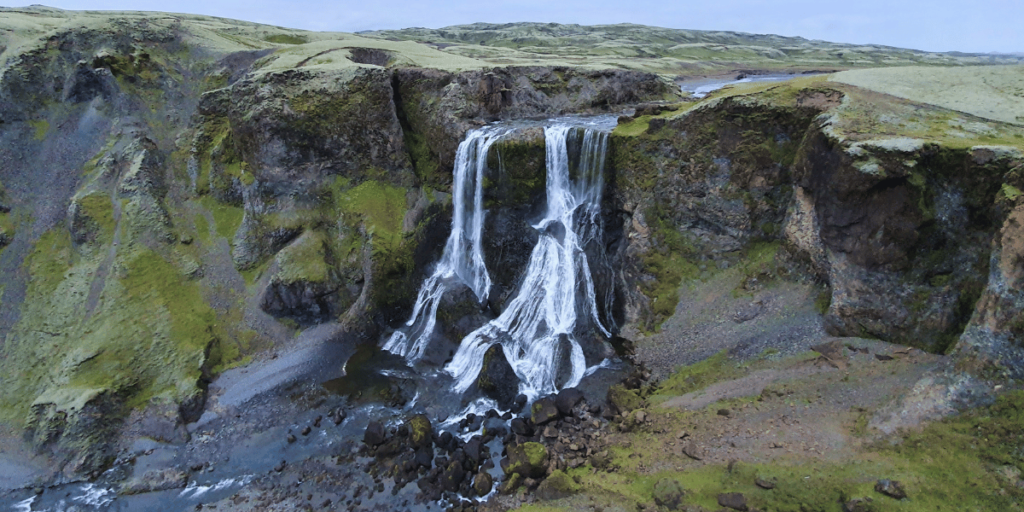
By Igor at Epic Iceland
Fagrifoss waterfall is located halfway into highland road F206 leading to the volcanic area of Laki craters. You can reach Fagrifoss only with a jeep or a capable 4×4 car. Once you arrive at the car park, it takes only an easy 5-minute walk to reach it.
There’s a huge viewing platform well situated right above the waterfall. This means you can see the magnificent Fagrifoss in its entirety in almost any kind of weather. Seeing Fagrifoss is a once-in-a-lifetime experience, more so if you combine it with a visit to the nearby Laki craters.
7. Bosnia and Herzegovina Kravice Waterfalls – Best Waterfall to Swim
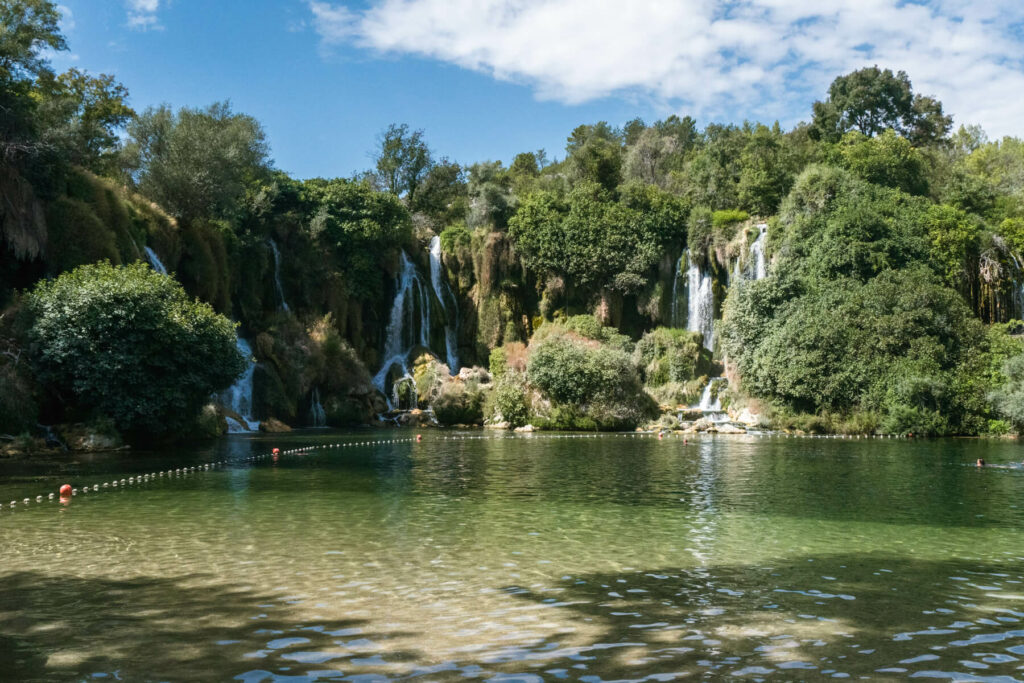
by Fernanda at Mauka Travels
The Kravice Waterfalls are one of the most visited natural sites in the Balkan region. Located in Bosnia and Herzegovina, only 40km from the city of Mostar, Kravice is a must-visit destination for waterfall lovers.
Kravice is formed by the Trebižat River, with its main waterfall being up to 28m high. Below the waterfall, a crystal-clear pool is formed, where people are allowed to swim. After a 20-min walk down, the river cascades into a smaller version of the waterfall called Mala Kravice (which literally means “small Kravice” in Bosnian).
Getting to the Kravice Waterfall is easy and accessible to everyone. There is a parking lot right in front of the ticket booth, and the walk down takes only 10min, either via stairs or the road. By the water, you will find various restaurants and bars that offer typical Bosnian barbecue and fresh drinks.
If you plan to get a good spot to spend the day, make sure to arrive early, as Kravice is a very popular summer destination. July and August are the busiest months of the year, combining the tourist crowds and the locals who go to Kravice Waterfalls during the summer break. June and September are the best months to visit as the weather is still very warm, but you will have far fewer crowds.
Besides swimming, you can also go kayaking or join a relaxing boat tour that navigates the stretch of river between the main and the smaller waterfalls. Both activities can be purchased directly on-site; there is no need to book beforehand.
8. Iceland: Godafoss – Fun Mythology
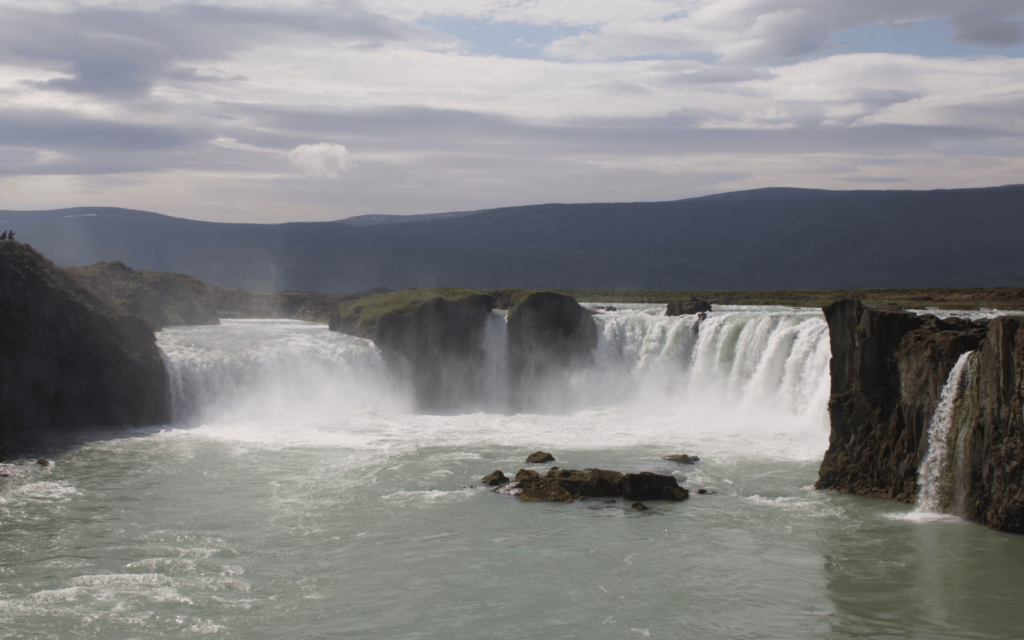
by Jina Lee
Located on Iceland’s Northern Coast, you’ll find the waterfall of the gods. Godafoss falls 12 meters and is the 4th largest river in Iceland. While you might think the waterfall gets its name for its scale, Godafoss is actually the site of an Icelandic myth. Legend says that Þorgeir Ljósvetningagoði threw Norse idols into the falls as a symbol of Iceland’s official conversion to Christianity.
There is a well-paved trail to the observation area from the parking lot. At the viewpoint, your eyes will be treated to a grand display of Godafoss buttressed by adjacent waterfalls with rolling hills in the backdrop. You can continue to walk the perimeter of the falls by following the signs and path. The trail is a 1.8 mile out-and-back, which takes a little under an hour to complete. If you’re feeling adventurous and able, you can climb down the rocks to get closer to the base of the falls (note: you can end up in the splash zone). If you’re pressed for time but interested in going down to the river, you’ll want to go along the east side of the falls where you’ll find the rock steps.
Godafoss is a must-see as part of any Ring Road trip. The falls are just off the main road on the way from Lake Mývatn to Akureyri. You can spend 1-2 hours before grabbing a bite to eat at the small restaurant located near the parking lot. You can also drive to one of the nearby towns such as Akureyri, Húsavík, and Mývatn, all of which are about a 45-minute drive away.
9. Albania Waterfalls: Theth (Grunas) Waterfall

By Carina at Bucketlist2life
Grunas or Theth waterfall is one of the most beautiful waterfalls in Albania and a great addition to your Albania itinerary. The waterfall was declared a natural monument in 2002. It is located in Albania’s Theth National Park in the Albanian Alps. The waterfall is at the foot of the Maja e Boshit (2414 m above sea level) at around 800 m above sea level hence you have great panoramas all around. It lies on the southern outskirts of the beautiful mountain town Theth near the Grunas Gorge of the same name.
The waterfall has a drop of about 30 meters. The water comes from a karst spring just above the fall and flows in a stream parallel to the Grunas Gorge and below it into the Shala River.
The walk there is a moderate 1.5 km or 1 mi hike with little elevation change. Only the last bit is steep and involves some scrambling. The hike will take you 50-60 minutes. You can either just hike to the waterfall or combine it with a hike to the famous Theth Blue Eye.
Theth itself is quite remote, in fact, the road was just recently paved. Most travellers come to do the well-known Theth-Valbona hike but you should definitely stick around to explore more of the area and one of the best waterfalls in Europe. Don’t miss the village’s famous stone buildings, particularly the church and the defence tower. Theth is becoming increasingly popular with tourists so you’ll find a good variety of accommodations and restaurants in the area.
10. Italy: Marmore Falls – Best in Italy
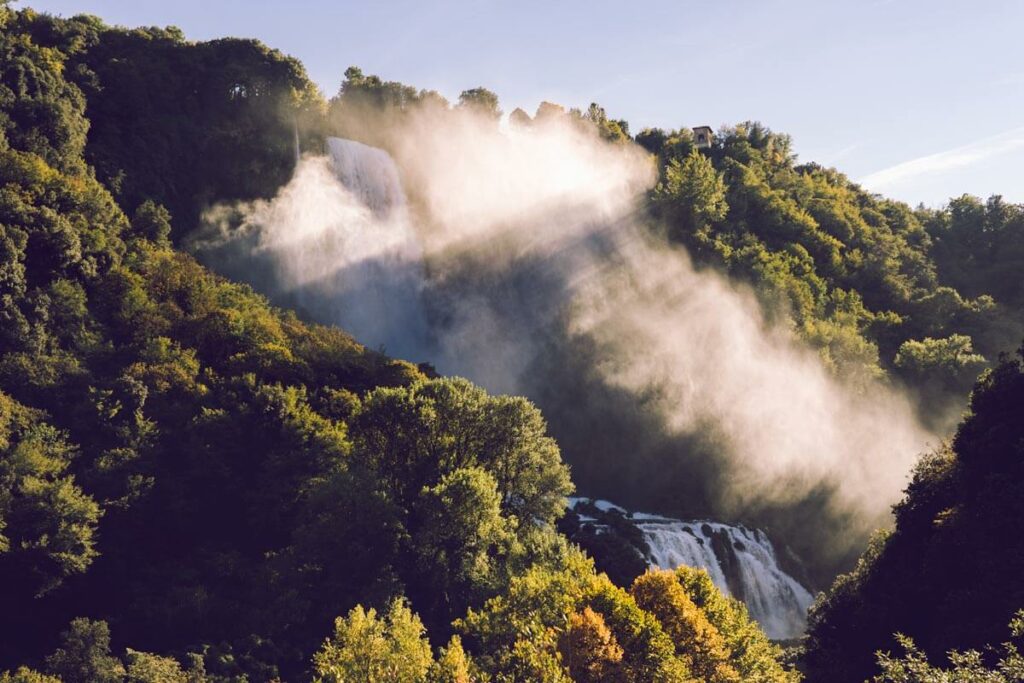
If you’re looking to discover Europe’s best waterfalls, then Marmore Falls in Italy simply can’t be ignored.
Marmore Falls is the tallest man-made waterfall in the world, and it was created by the Romans more than 200 years BC. Apart from being a historical treasure, Marmore Falls is also located in a beautiful place where you can go hiking and enjoy some nature trails. On top of that, Marmore also runs through a hydroelectric power plant, which means it generates electricity to many households in the area.
It’s safe to say that Marmore Falls is an interesting waterfall. Luckily, it’s not hidden away in a deep forest, it’s actually fairly easy to get to. Located only 8 kilometers away from Terni, you can easily jump on the train from Terni Station to Marmore. From Marmore Station it’s only a short walk to the entrance of the waterfall. Get your ticket here and start exploring!
Marmore Falls have 3 different tiers, which you can visit by hiking through the park. It’s not a difficult or long hike, but it’s steep and therefore not wheelchair friendly. Make sure to wear a raincoat when visiting tier 1 and tier 2 since you can get really wet.
Notice that the waterfall is “turned on” during specific times a day, which is when huge amounts of water is released. This is when the waterfall appears beautiful and powerful, and it’s when you get to see the best of Marmore! Make sure to also visit the Belvedere Pennarossa Inferiore viewpoint to get a full view of Marmore Falls.
11. Iceland: Gulfoss – One of the Largest Waterfalls in Europe
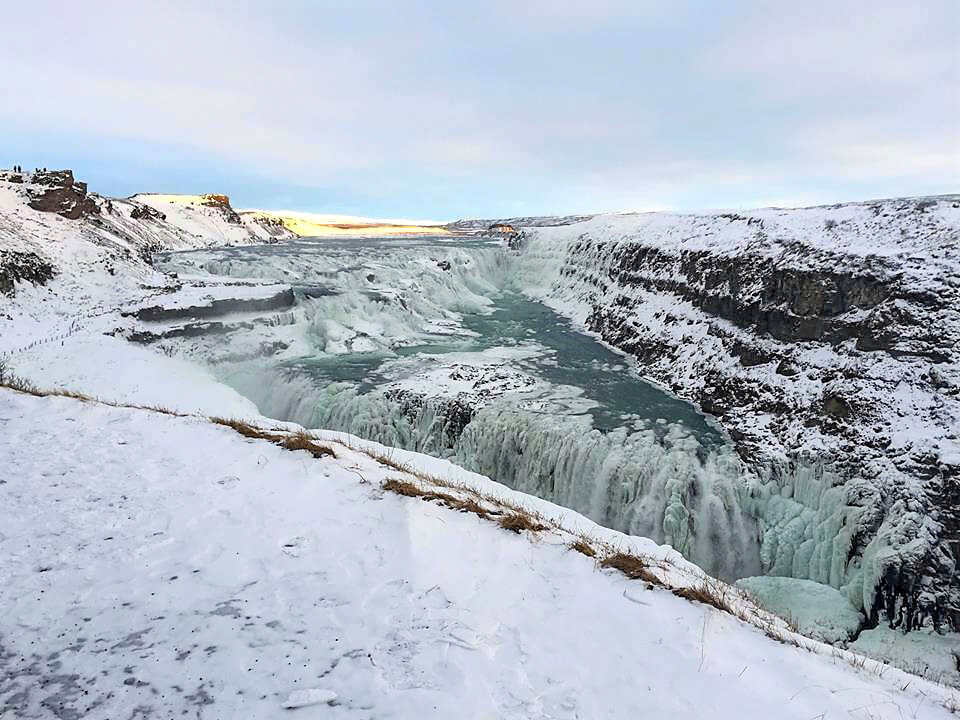
by Lucy and Dan at Thoroughly Travel
Situated in the west of Iceland, Gullfoss Waterfall is an impressive cascade and one of the best waterfalls to visit in Europe. Straddling the powerful Hvítá River, Gullfoss is one of the three main stops on Iceland’s Golden Circle, and an easy day trip from Reykjavík. Featuring an impressive double drop, water plunges a total of 32 metres (105 ft) over the edge before continuing down the dramatic Haukadalur Valley.
Gullfoss means Golden Waterfall, which is a reference to the rainbows and sparkles that dance in the falls’ splash. In Winter the river often freezes, creating vast columns of ice, while in Summer the waterfall is framed by lush vegetation. The 1.3 mile (2.1km) out-and-back trail is an easy route and takes around 30 minutes to walk. Informational boards line the path and there are several viewing areas from which you can admire the waterfall. Take some time to read about Icelandic activist Sigríður Tómasdóttir, whose campaigning helped preserve the Gullfoss waterfall and protect it from industrialisation.
At the entrance there is a car park and gift shop, as well as the Gullfoss Panorama Restaurant, which boasts panoramic views of the Gullfoss Nature Reserve. As a popular tourist destination, the site is included as part of many day tours and can be busy in peak season. Early morning and late afternoon are the best times to visit to avoid any crowds, whilst also being popular with photographers who can take advantage of the golden glow cast at sunrise and sunset.
Gullfoss Waterfall is easily accessible by car and just under 2 hour’s drive from Reykjavík. It is popularly combined with the Geysir Geothermal Area and Thingvellir National Park, the other two stops on the Golden Circle.
12. Romania: Toplita Thermal Cascada – Best in Romania
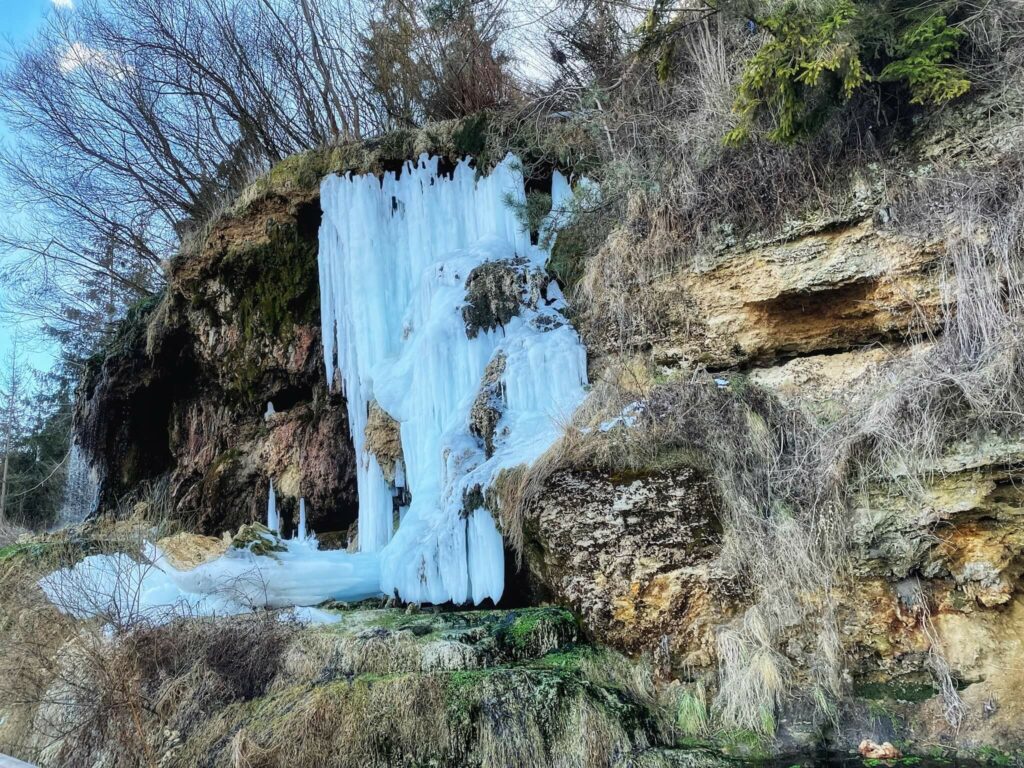
Toplita is an authentic Romanian town famous for its tiny ski resort, good food and melange of new and old ways of life. You’re just as likely to see a BMW X5 or a horse pulled carriage on the road. It’s located in the Harghita county and known for its picturesque landscapes and natural beauty, including the Toplita thermal waterfall. The waterfall is located in the heart of the town and it cascades down from a height of about 12 meters.
The waterfall is fed by the Toplita Stream and is rich in calcium causing very interesting colors and the 27 degree water only freezes during the heart of winter such as the photo above taken in February.
In summer, the best nearby activities including hiking, mountain biking and riding e-bikes. Visitors can take a leisurely stroll along the path that winds its way through the forest, stopping to admire the waterfall and the surrounding scenery. The waterfall is also a popular spot for photography, as the mist created by the falling water creates a dreamy and ethereal atmosphere.
Take a look at the waterfall and then make sure to eat at the friendly Izabella restaurant in the middle of town overlooking the river.
13. Iceland: Aldeyjarfos – Most Isolated
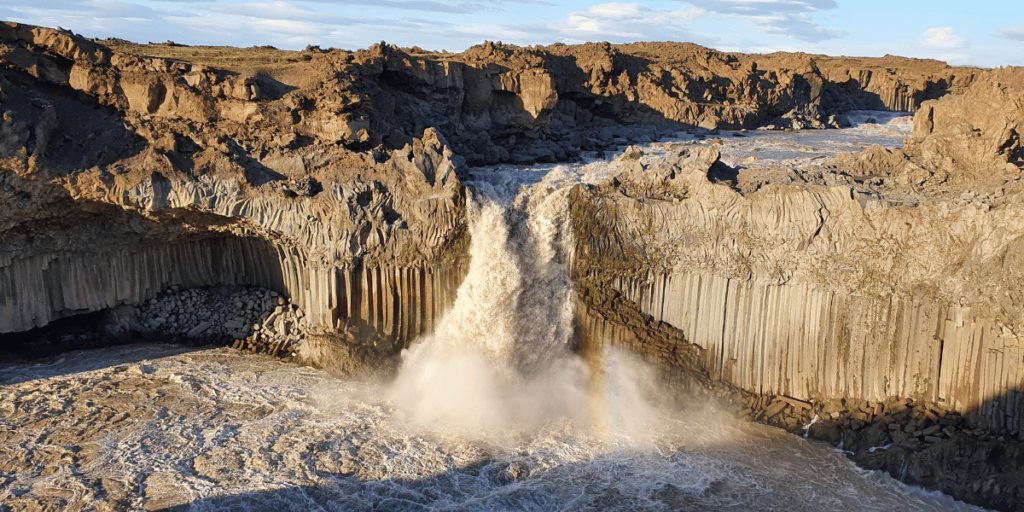
by Igor of Epic Iceland
Aldeyjarfoss is one of the best waterfalls in the world a stunning waterfall full of otherworldly rock formations. You can find Aldeyjarfoss at the beginning of the northern part of the mountain road F26, close to Akureyri and Mývatn. Aldeyjarfoss is accessible only in summer and you need a 4×4 car to reach it.
There’s no hiking trail, nor any viewing platform at this best waterfalls in Iceland. Aldeyjarfoss is a wild waterfall and it takes around 10 minutes to reach it by an easy hiking trail from the car park. The most beautiful view of Aldeyjarfoss you can get is undoubtedly during the sunset.
14. Slovenia: Peričnik Waterfall – Most Dreamy
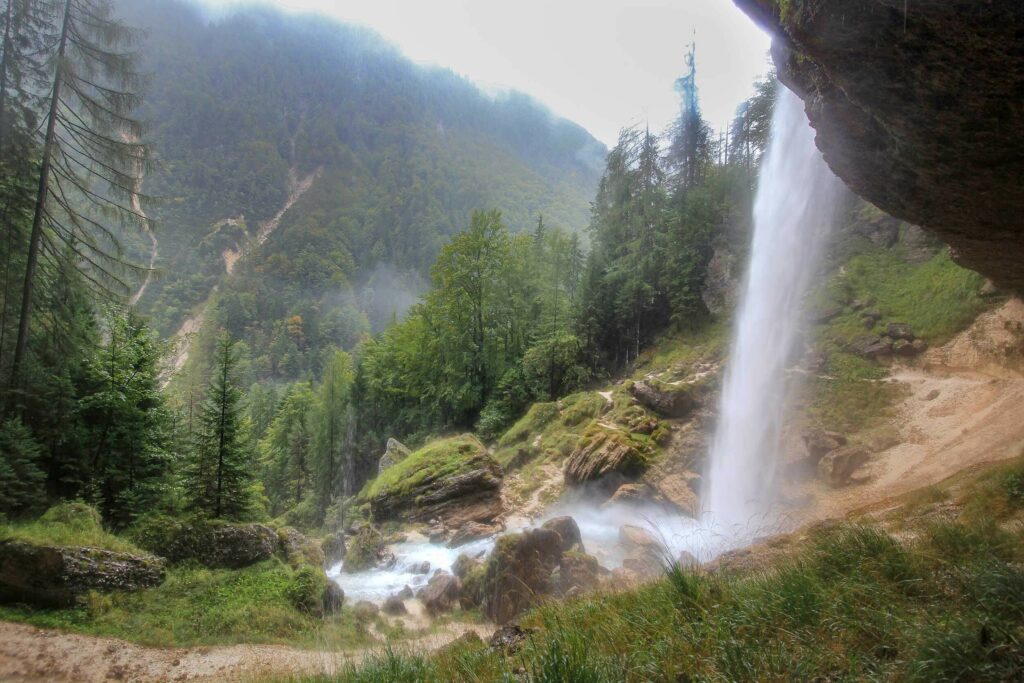
by Places of Juma
Pericnik Waterfall in Slovenia, or also known as Slap Peričnik, is definitely one of the most spectacular waterfalls in Europe. Located just a few kilometers from the winter resort of Kranjska Gora, it is one of the highest waterfalls in Slovenia, with a height of almost 52 meters. But not only the imposing height is breathtaking, these falls are particularly photogenic, and so brilliant pictures can be taken here.
The pocket of Trieste Italy, Slovenia and Croatia makes for a perfect roadtrip to experience the best of the mountains and sea all within 2 hours drive.
A real special feature is that as a visitor, you can get very close to the roaring waterfall. A well-secured, narrow path even leads directly behind the waterfall. If you don’t want to get wet, you should definitely pack rain gear and waterproof shoes! The feeling of almost being part of these water masses is simply unique and an experience in itself.
From the parking lot, this beautiful Pericnik waterfall is easily accessible via a short, but relatively steep hiking trail. It is also great that you can visit this natural wonder all year round. Beautiful and really cooling is a visit in the summer. Even in rainy weather, the atmosphere is gigantic. However, an insider tip is a visit on very cold winter days when the water masses are frozen.
But also the surrounding area around the waterfall is beautiful and invites to numerous hikes. A highlight is also the Slovenski planinski muzej, a mountaineering museum on Slovenian mountaineering history with virtual summit tours and Escape Game.
As an accommodation tip, we recommend the charming Hostel LUKN’A, which is located just a few kilometers from the waterfall.
15. Ireland: Poulanass Waterfall – Most Dog Friendly

By Leslie from Backpackers Thailand
Thanks to Ireland’s rainy climate, the Emerald Isle has some of the most scenic waterfalls, which, unlike many waterfalls in Asia, are always full. Poulanass Waterfall is a small and picturesque waterfall located in the Glendalough Valley, co. Wicklow. This valley is a part of the Wicklow Mountains National Park – one of the most stunning regions in all of Ireland with one of the best waterfalls in Europe.
Poulanass is located just an hour away from Dublin, so you can easily get there by car, by bus #183 from Blessington, which drops you at Glendalough Visitor Centre, or by booking an organized tour. Poulanass Waterfall is a very popular spot, which is included in almost all the Glendalough day trips from Dublin, so you have many travel options.
The 1.7 km hike to the waterfall (known as the Pink route) is very pleasant and is suitable for adults and older children. On the way there, you’ll meet many tourists and local families who come here for a weekend hike or to walk a dog (the trail is dog-friendly). The gravel road to the waterfall passes through the lush mossy forest and by the picturesque lower and upper Glendalough lakes, which are an absolute must-see.
Poulanass waterfall is multi-leveled, with the largest segment measuring around 5 meters high. The best view of the waterfall opens from the observation deck on the trail right next to the waterfall. If you’re feeling adventurous, you can keep walking this trail which will take you to one of the plenty of Glendalough walks.
Even if you don’t anticipate doing some major hikes in Glendalough, it’s always a good idea to have a trusty rain jacket on hand just in case – regardless of the time of year. After all, it rains there quite often.
There are free toilets located at the Visitor Centre and near the car parking at the Upper lake.
Fancy a dinner? After a long day of hiking in Glendalough valley, there’s nothing better than stopping by the family-run Wicklow Heather Restaurant for a hearty meal.
16. Madeira: Levada do Caldeirao Verde : Magical Forest

By Millie from Stay Wild Travelss
Levada do Caldeirão Verde is one of the best waterfall hikes on Madeira island. The 12-kilometre trail leads along a flat path alongside an old aqueduct, through a lush green forest, and often above a bed of clouds, before arriving at one of the most impressive waterfalls in Europe – Caldeirão Verde Waterfall.
Since the trail is predominately flat, it’s popular among many novice and experienced hikers, as well as families. Depending on how busy the trail is, you should be able to complete the trail within 3-4 hours. Due to the popularity of the trail – and the fact it’s an out-and-back route along a fairly narrow path – it’s recommended to begin this trail early in the morning to enjoy a traffic-free walk.
In order to get to the trailhead, you’ll need to rent a car or book this hike through a tour company on a platform such as GetYourGuide. It’s possible to get the bus, however, you’ll need to factor in an additional 1.5km each way from the bus stop to the trailhead. The bus from Funchal is number 138 and takes just over an hour.
Since the trail begins in the mountains, you’ll need to be prepared for some tropical weather. As such, it’s best to ensure you’re wearing waterproof hiking boots and wet weather clothing to prepare for the likely event of a short down poor.
Whilst there are no facilities directly on the trail, you’ll find a lovely café at the start/end of the walk that serves excellent hot chocolate and honey cake made from the local beehives.
17. Spain: Chorreras Negras Cascades : Best Winter Hike

By Linn Haglund of Andalucia Hiking
One of the most mesmerizing waterfalls in Europe is on the top of the Siete Lagunas trek in Spain’s Sierra Nevada National Park. This is a strenuous hike where that takes you on a 1500 meters ascent in only 9 kilometers from the whitewashed mountain village of Trevelez. It is recommended to bring hiking poles to support yourself and your knees on this hike. It is also recommended to wear comfortable leggings for hiking or hiking pants that you can zip off to shorts to deal with temperature differences. But most importantly sturdy hiking boots.
This is not a walk in the park and you should be physically prepared as much as you need to bring the right gear. The cascades of Chorreras Negras rush down from 2900 meters of altitude on the steepest part of the hike as you climb up the rough zig-zag path to reach the seven lagoons (which of you will normally not see more than one of two with water.)
The falls slide down naked rock before they melt into the glittering river that flows down the valley and across green meadows. The beauty of the area is beyond magnetic and the contrasts between the raw, high altitude mountain and the lush greenery below make it all worth the grueling hike to reach it. The trailhead is easy to find at the top of Trevelez village. The easiest way to get there is by car and there is free parking in the village.
18. Austria: Rosengartenschlucht: Best Kid Hike
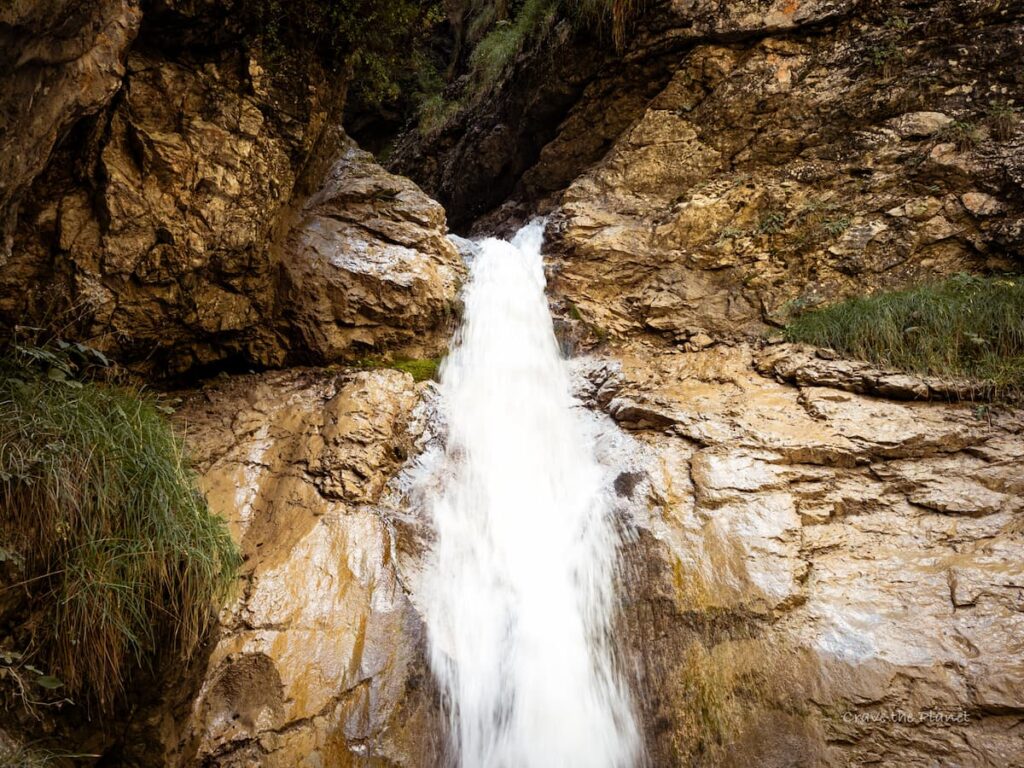
Here’s a possible rewrite:
Hiking in Imst, Austria is a hidden gem that we loved, especially the jam-packed nature hike from old town to the famous Imst alpine coaster. With a refreshing work-a-day vibe, Imst is a welcome break from the crowds and cuteness overload of other popular destinations like Garmisch.
This short 1-mile hike is absolutely stunning, featuring spouting waterfalls, caves, hanging bridges, and milky blue tumblers of a river in the gorge. It’s the perfect break from the hot sun or a nice walk to get to the alpine coaster. Don’t miss out on this breathtaking experience!
More European Outdoor Travel & Hiking Tips
Immerse into your senses with:
📚 Top hiking books
🎧 Inspiring hiking podcasts
➡️ Is Paragliding Safe?
and the best Nature quotes, Mountain Quotes & Dolomites Quotes to inspire wonder.
FAQ: Europe Waterfalls
Which country has the most beautiful waterfalls in Europe?
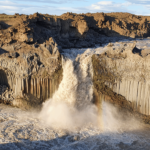
1. Croatia: Veliki Slap
2. Iceland: Aldeyjarfos
3. Madeira: Levada do Caldeirao Verde
4. Slovenia: Peričnik Waterfall
5. Romania: Toplita Thermal Cascada
6. Italy: Marmore Falls
7. Albania: Theth (Grunas) Waterfall
8. Azores: Poço da Ribeira do Ferreiro
9. Spain: Chorreras Negras Cascades
10. Bosnia and Herzegovin Kravice Waterfalls
What is Europe’s Largest Waterfall?
The Rhine falls in Switzerland is the most powerful waterfall in Europe. It is a top Europe destination and one of the biggest waterfalls in the world.
What are the Best Waterfalls in Switzerland?
You’ll notice I’ve left off most of the Alps on this list. That’s because I’ll be writing a very HIKING specific waterfall bucketlist where Swiss waterfalls play a huge role. Stay tuned!
Waterfalls Europe Photography
It’s so much fun to take waterfall photos and I hope to take photos of the biggest waterfalls in the world and highest waterfalls in Europe someday. While it’s not the largest waterfall in Europe, my friends and I really had a blast hiking and doing a fashion shoot at the Schlegeisspeicher in Austria with the Schrammach waterfall. Here’s some tips to help out your next photo session.
- Use a tripod: Waterfalls often require a slow shutter speed to capture the movement of the water, and a tripod will help keep your camera from shaking.
- Experiment with slower shutter speeds: Play around with different shutter speeds to get the desired effect for the water. A slower shutter speed will create a silky and smooth result, while a faster shutter speed will freeze the movement of the water and it looks harsh.
- Use an ND polarizing filter: A polarizing filter will help reduce glare and increase the saturation of the colors in the scene.
- Use a wide-angle lens: A wide-angle lens will allow you to capture more of the scene, including the surrounding landscape.
- Sunrise or Sunset Golden Hour: The best time to take photos of waterfalls is during the “golden hour”, when the sun is low in the sky and the light is warm and soft, this will help you to get a great contrast and reflections in the water.
- All good photos are edited: Use cloud based software like Lightroom to quickly edit your photos and make them look their best before you share on social media.
Get OFF the Beaten Path with Hut to Hut Hiking in the Swiss Alps
The best way to experience the stunning Bernese Oberland filled with dramatic mountains and waterfalls, picturesque villages and wildlife.
Walk each day from one high elevation mountain hut to the next where they provide:
- Local delicious mountain foods and wine
- Warm comfortable beds
- A chance to connect to what really counts
Immerse in Nature and Support Rural, Small Businesses for the Vacation of a Lifetime.

Author profile: Morgan Fielder is a Doctor of Physical Therapy and passionate hiker who believes in exploring the world on foot with good food. Follow her journey as she shares science-based hiking tips and advocates for sustainable tourism.

